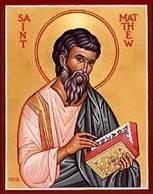Calling of Matthew
CALLING OF MATTHEW

Objectives:
- Students should know that Matthew was a tax collector.
- Students should know that Matthew was one of Jesus’s disciples.
- Students should memorize the 12 disciples.
Possible Lesson Plan:
- Open with prayer.
- Scripture References: Matthew 9:9-13 and Luke 5:27-39. What was Matthew’s job? Was he liked by most people? Why or why not?
- Historical reference: Publicans, or tax collectors, were Jews who contracted with the Roman government to collect taxes for them. They routinely charged more to the Jews than the Romans demanded, keeping the profit for themselves.
 Talk a bit about liking people: Make 2 columns on your chalkboard or large tablet, one labeled “good” and one “bad”. What makes someone a good friend, a nice person? Have the students come up with some characteristics. What makes someone a “bad” person? Did most people think Matthew was a nice person or a bad person? Why? Did most people like Matthew? Did they visit him? Were they nice to him? How did Jesus treat Matthew? Read the “Golden Rule” in Luke 6:31-33. Do you know some people who are not so nice? How do we treat people who are not so nice? Are we being like Jesus?
Talk a bit about liking people: Make 2 columns on your chalkboard or large tablet, one labeled “good” and one “bad”. What makes someone a good friend, a nice person? Have the students come up with some characteristics. What makes someone a “bad” person? Did most people think Matthew was a nice person or a bad person? Why? Did most people like Matthew? Did they visit him? Were they nice to him? How did Jesus treat Matthew? Read the “Golden Rule” in Luke 6:31-33. Do you know some people who are not so nice? How do we treat people who are not so nice? Are we being like Jesus?
- Play a learning game: “Name the Twelve”. We’re still working on the names of the twelve disciples. Print the names on strips of paper and pin a paper to the back of each student. The students must find out which disciple they are by asking the other students yes or no questions. Have the student sit down when he or she thinks he knows who he is. If anyone can’t seem to guess, give clues, e.g., begins with B, etc.
- Make a Money Pouch: Take a circle of leather or heavy fabric or felt. Cut 8 holes around the top. Use 2 shoelaces or heavy yarn or twine for each pouch and lace around the top, one in each direction. Pull tight and knot drawstring. Decorate the outside with fabric markers or acrylic paint if desired.
- . Now make a coin for the pouch. When Jesus was asked if we should pay taxes to the government, He replied, “Render to Caesar the things that are Caesar’s, and unto God the things that are God’s” (Luke 20:25). Take a piece of self-hardening clay and flatten into a disk. On one side, the children can draw with a pencil or skewer the image of Caesar, and on the other a picture of your church, or the Jewish temple. Allow to dry for the week and send home in the pouches next week.
- Close with prayer: Have students pray specifically for someone who does not seem to be very nice and continue praying through the week.